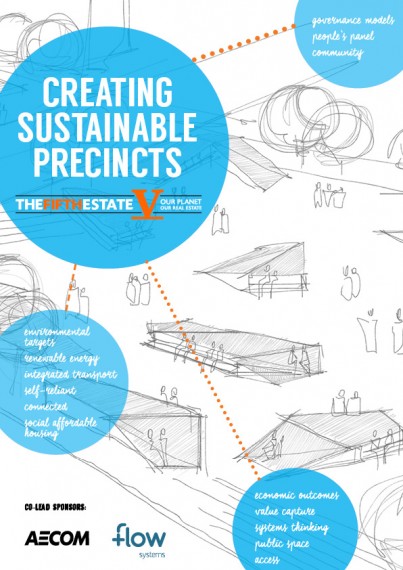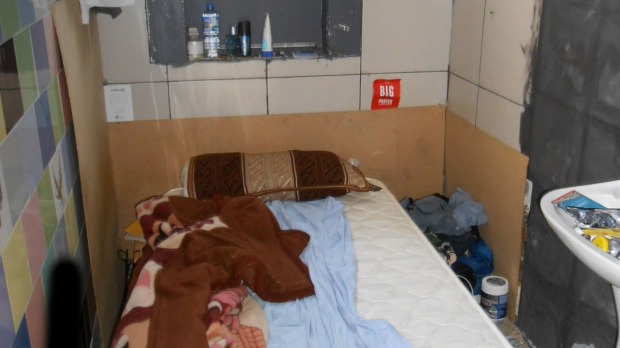Many in the policy community were taken unawares by the Australian Government’s recently announced intent to re-engage with matters urban. In creating a ministry for Cities and the Built Environment, the new Prime Minister has refreshingly acknowledged that ‘liveable cities, efficient, productive cities, the environment of cities, are economic assets’. This development has coincided neatly with the publication of a hefty research-based overview on the geography and impacts of concentrated disadvantage in Australia’s major cities [Read more →]
Urban disadvantage study presents challenge for new Minister
Posted by Hal Pawson on September 26th, 2015 · Uncategorized
Precincts and sustainable built environments
Posted by Chris Martin on September 22nd, 2015 · Planning reform, Wellbeing
By Greg Paine, Research Officer, City Futures Research Centre, City Wellbeing Program.
Professor Susan Thompson and I were invited to attend a recent “Surround Sound” forum hosted by The Fifth Estate (TFE), the weekly e-newsletter on sustainable building. The forum focused on how precincts can be key to achieving sustainable built environments, and thus a sustainable society. The invitation followed the Program’s earlier contribution to TFE’s e-book on precincts which brought together the results of a previous intensive discussion convened last year.
So what was it all about? [Read more →]
New Minister for Cities and the Built Environment
Posted by Chris Martin on September 21st, 2015 · Cities, Government
As well as having a new Prime Minister, and a new ministry, we now have for the first time a Minister for Cities and the Built Environment.
Prime Minister Malcolm Turnbull has appointed the Hon Jamie Briggs MP to the new role, and signalled a renewed engagement by the Federal Government in urban policy, including housing affordability: [Read more →]
The informal lodging sector in NSW: a regulatory blind spot
Posted by Chris Martin on September 14th, 2015 · Affordability, Marginal rental
Originally published in Parity magazine (Council to Homeless Persons).
Fifty-eight beds, in 19 makeshift rooms, in a three-bedroom house. Ten people lodging in a single bedroom. Beds installed on apartment balconies, in bathrooms and laundries and, in one case, a pantry. A shower installed in a hall.
These are some of the housing arrangements uncovered by officers of the City of Sydney in the course of recent investigations into illegal accommodation in the City. They represent some of the worst and most extreme examples of accommodation offered by an extensive, informal sector of our housing system, that provides lodgings in shared residential spaces, such as otherwise ordinary houses and apartments. And despite the response of the City of Sydney in these cases, the present regulation of the sector is unsatisfactory. [Read more →]
Strata renewal reforms: compulsory acquisition for private profit
Posted by Chris Martin on September 7th, 2015 · Guest appearance, Strata
By Cathy Sherry, Senior Lecturer, Faculty of Law, UNSW. Originally published at the Sydney Morning Herald. City Futures’ research on strata renewal is here.
The New South Wales government has released an exposure draft of strata termination legislation which empowers private citizens to forcibly acquire other people’s homes.
People who live in their own apartment face the risk that their neighbours, investors in their building or a developer will decide that they can make a lot of money out of redeveloping the land, and irrespective of another owner’s desires or needs, that owner will be forced to sell. So long as 75 per cent of owners agree, (many or all of whom may be investors or a single developer), the site can be collectively sold or redeveloped. [Read more →]
Is the NDIS housing exodus coming?
Posted by Ilan Wiesel on August 31st, 2015 · Uncategorized
Just how big is the NDIS? Total funding for disability services will triple from $7 billion in 2012-13 to $22.2 billion in 2019-20, the first year the scheme will be fully rolled out nationally. Approximately 460,000 people with significant long-term disability will receive individualised NDIS funding packages to purchase disability support services.
And just how big are the housing implications of the NDIS? The estimation of unmet need in affordable housing for 83,000-122,000 NDIS participants certainly says something about the scale of the challenge. But this crude estimation also demonstrates a very high degree of uncertainty and it is unclear how much of it can be interpreted as growth in demand that can be directly attributed to the NDIS. [Read more →]
Get rid of stamp duty – but don’t expect improved housing affordability
Posted by Chris Martin on August 20th, 2015 · Affordability
Stamp duty is Australian tax reform’s pantomime villain, booed and hissed by everyone whenever it appears on stage. As a tax levied on transfers – in particular, transfers of real property, including housing – it is decried by economists as a lumpy and inefficient cost to transacting parties, and an unhappily volatile revenue source for State and Territory Governments. The Howard Government’s GST deal was supposed to get rid of it; the Henry Tax Review would have abolished it; and just about every interest group in the housing sector – from ACOSS and National Shelter to the Real Estate Institute and the Property Council – say they want it gone. This week the Housing Industry Association has held a summit focused on tax reform and ‘killing stamp duty once and for all.’
Okay, stamp duty is bad – but it’s not all bad, and it’s not bad for the reasons most people think. [Read more →]
Rooming house residents not yet adequately protected
Posted by Hal Pawson on August 13th, 2015 · Uncategorized
(Self-portrait in front of boarding house – Charles Blackman)
Recent reforms to rooming house (or boarding house) regulation have as yet proved only partially effective in ensuring better resident outcomes in this relatively high risk form of accommodation. The new oversight systems established in parallel in 2012 in NSW and Victoria both involved the creation of state-wide rooming house registers and alterations to joint working between state and local governments. To some extent these moves may be seen as paralleling the increasingly intensive official scrutiny of rooming house-type premises in countries such as the UK. [Read more →]
What choice for tenants in Australia’s public housing transfers?
Posted by Hal Pawson on August 10th, 2015 · Uncategorized
By Hal Pawson and Ilan Wiesel
Recent years have seen federal and state governments taking a growing interest in transferring public housing to community housing providers (CHPs). CHP tenants may receive rent assistance (RA), whereas public housing tenants cannot. For this reason alone, such transfers can inject significant additional funds, captured indirectly through rent, into a starved social housing system. Some states have also justified transfers with the claim that these will result in better and ‘more responsive’ housing services. [Read more →]
Inquiry into affordable housing industry capacity
Posted by Chris Martin on July 29th, 2015 · Affordability, Housing
City Futures is partnering with RMIT, Swinburne, UQ and UTas to conduct an Inquiry into Affordable Housing Industry Capacity for AHURI.
We’re looking at Australia’s small but growing affordable housing industry – including community housing providers, their funders and other partners – and investigating the capacity of this industry to restructure the social housing system to better deliver housing for low-moderate income households. [Read more →]









